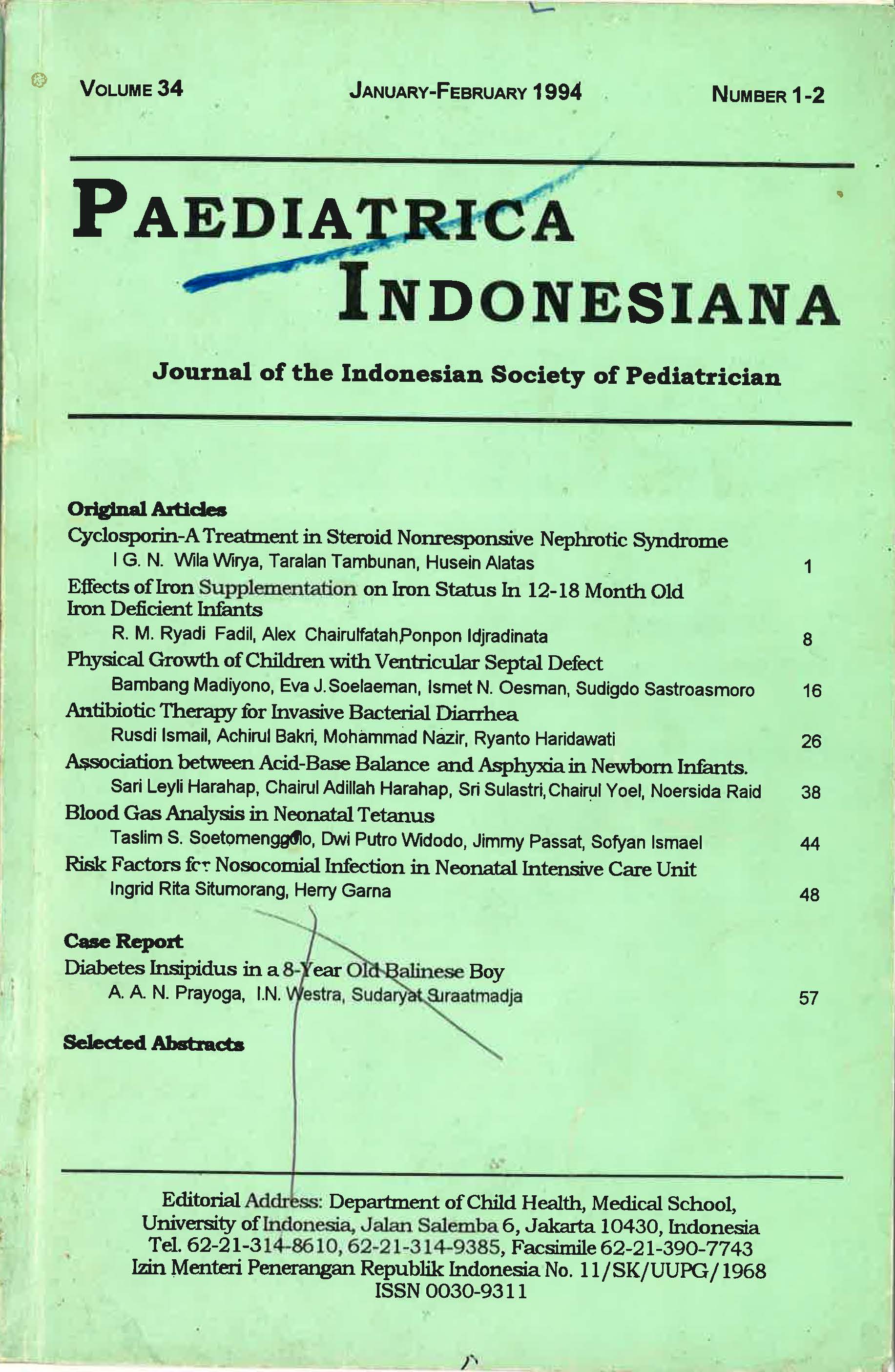Blood Gas Analysis in Neonatal Tetanus
DOI:
https://doi.org/10.14238/pi34.1-2.1994.44-7Keywords:
blood gas analysis; neonatal tetanus; metabolic acidosis;Abstract
We reviewed the results of arterial blood gas analysis in 127 patients with neonatal tetanus on admission, and in 52 of such patients on the day before they died. All patients were hospitalized at the Department of Child Health, Cipto Mangunkusumo Hospital, Jakarta. On admission, most patients showed uncompensated metabolic acidosis. The mortality of patients wjth pH ofless than 7 was 100%. There was no significant difference between the mortality of patients with pH 7.35-7.45 and those with pH of less than 7.35. Analysis of acid-base balance indicated that ventilatory fw1ure was the most common finding in 52 patients who subsequently died. We recommend using intravenous fluid containing a combination of 5% dextrose and sodium bicarbonate with 4 : 1 (vol/vol) ratio from the fust day of hospitalization to reduce the possibility of the development of ongoing metabolic acidosis in patients with neonatal tetanus. Maintaining adequate ventilation is mandatory ln such patients.
References
2. Smythe PM. Studies on neonatal tetanus; and on pulmonary compliance of the totally relaxed infant Br Med J 1963; March 2: 565-71.
3. Athavale VB, Pai PN. Tetanus neonatorum - clinical manifestations. Trap Pediatr 1965; 67: 649-57.
4. Rayudu GBS, Grover JM. Neonatal tetanus in a military hospital. Indian J Pediat 1974; 41:33-9.
5. Salimpour R. Cause of death in tetanus neonatorum. Arch Dis Child 1977; 52: 587-94.
6. Shapiro BA, Harrison RA, Walton JR. Clinical approach to interpritation. Clinical aplication of blood gases, 2nd ed. London: Year Book Medical Publ.1978; 133-44.
7. Astrup P, Anderson OS, Jorgensen K, Engel K. The acid-base metabolism - A new approach. Lancet 1960; 1:1035-9.
8. Husada TJ, Munir A. Failure of high dosage of valium in the treatment of neonatal tetanus. Paed.iatr Indones 1980; 20:51-6.
9. Soetomenggolo TS, Purboyo RH, Hendarto SK, lsmael S. Neonatal tetanus treated with diazepam as single antispasmodic agent Paediatr lndones 1981; 21:101-6.
10.Sugitha N, Suwendra P, Suraatmaja S. High dosage diazepam as single antispasmodic agent in treatment of neonatal tetanus. Paed.iatr Indones 1983; 23: 163-72.
Downloads
Published
How to Cite
Issue
Section
License
Authors who publish with this journal agree to the following terms:
Authors retain copyright and grant the journal right of first publication with the work simultaneously licensed under a Creative Commons Attribution License that allows others to share the work with an acknowledgement of the work's authorship and initial publication in this journal.
Authors are able to enter into separate, additional contractual arrangements for the non-exclusive distribution of the journal's published version of the work (e.g., post it to an institutional repository or publish it in a book), with an acknowledgement of its initial publication in this journal.














